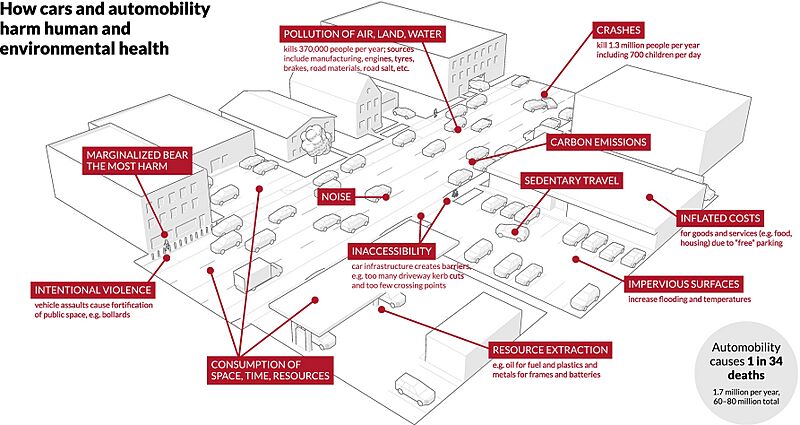Image: Illustration of examples of mechanisms by which automobility harms people and the environment

Description: "This review synthesises the negative consequences of the system of automobility, or car harm (Fig. 1). We have grouped car harm into four categories (Fig. 2): violence (crashes and intentional violence); ill health (pollution, sedentary travel, and dependence and isolation); social injustice (unequal distribution of harm, inaccessibility, and consumption of space, time, and resources); and environmental damage (carbon emissions, pollution and resource extraction, and land use)." "Cars are the default mode of transportation in thousands of cities, suburbs, and towns around the world. Meanwhile trains, buses, bicycles, wheelchairs, and even our own bodies are discussed as “alternative” transportation. Yet there are just 16 cars for every 100 people on the planet (China Association of Automobile Manufacturers, 2021; International Organization of Motor Vehicle Manufacturers, 2017; Japan National Statistics Center, 2022; World Health Organization, 2018). While some people benefit from the default position of cars, nearly everyone—whether or not they drive—is harmed by it. In other words, human settlements are dominated by automobility, “an interlocking system of cars, highways, fueling infrastructure, automotive companies, government policies, and car cultures” (Sheller, 2018, p. 13)." "Despite the widespread harm caused by cars and automobility, governments, corporations, and individuals continue to facilitate it by expanding roads, manufacturing larger vehicles, and subsidising parking, electric cars, and resource extraction. This literature review synthesises the negative consequences of automobility, or car harm, which we have grouped into four categories: violence, ill health, social injustice, and environmental damage. We find that, since their invention, cars and automobility have killed 60–80 million people and injured at least 2 billion. Currently, 1 in 34 deaths are caused by automobility. Cars have exacerbated social inequities and damaged ecosystems in every global region, including in remote car-free places. While some people benefit from automobility, nearly everyone—whether or not they drive—is harmed by it. Slowing automobility's violence and pollution will be impracticable without the replacement of policies that encourage car harm with policies that reduce it. To that end, the paper briefly summarises interventions that are ready for implementation."
Title: Illustration of examples of mechanisms by which automobility harms people and the environment
Credit: https://www.sciencedirect.com/science/article/pii/S0966692324000267
Author: Authors of the study: Patrick Miner, Barbara M. Smith, Anant Jani, Geraldine McNeill, Alfred Gathorne-Hardy
Usage Terms: Creative Commons Attribution 4.0
License: CC BY 4.0
License Link: https://creativecommons.org/licenses/by/4.0
Attribution Required?: Yes
Image usage
The following page links to this image:

